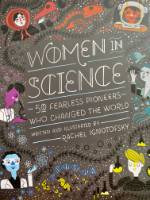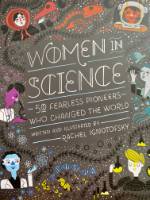Summary
This collection of lessons aims to shine a spotlight on the remarkable contributions of women in the field of science. It celebrates the countless women who have defied societal norms and overcome obstacles to pursue their passion for scientific discovery, serving as role models for future generations of aspiring scientists. Through these lessons, we not only acknowledge their invaluable work, but we also underscore the importance of gender diversity and equality in the world of science.Resources

In this lesson, students will explore the impact female scientists have had on what we know about respiration. Aerobic respiration should be taught before doing this lesson. Students will discover the impact Gerty Cori has had on our understanding of respiration. Students will determine how the alternative... Read more »
Woman Crush Wednesday: Gerty Cori
From Molecules to Organisms: Flow of Energy
- Individual Career Academic Plan (ICAP)
- Science
- Biology
- 9th - 10th
- B.LS1.7, B.LS2.3

This lesson is part of the "Woman Crush Wednesday" series that looks at the ways female scientists have shaped our views of science. In this biology lesson, students will explore the many contributions of Jane Cooke Wright, with special attention on her study of the impact of uncontrolled cell division... Read more »
Woman Crush Wednesday: Jane Cooke Wright
Understanding Mitosis
- Science
- Biology
- 9th - 10th
- B.LS1.4 , B.LS1.4.1

This lesson is part of a series, titled "Woman Crush Wednesday" in which we look at how female scientists have shaped our view of science. In this biology lesson, students will explore the contributions of Marjory Stoneman Douglas, the interconnectedness of an ecosystem, and endangered species. Read more »
- Science
- Biology
- 9th - 10th
- HS-LS2-6, HS-LS4-5, B.LS2.6 , B.LS4.5

This lesson is part of a series, titled "Woman Crush Wednesday," where we look at how female scientists have shaped our views of science. In this biology lesson, students explore the contributions of Nettie Stevens and her discovery of sex chromosomes. Read more »
Woman Crush Wednesday: Nettie Stevens
Inheritance and Variation of Traits
- Science
- Biology
- 9th - 10th
- B.LS3.1 , B.LS3.2

This lesson is part of a series, titled "Woman Crush Wednesday" in which we look at how female scientists have shaped our view of science. In this biology lesson, students will explore the contributions of Rachel Carson, the impact of human activity on our ecosystem, and how organisms develop resistance... Read more »
Woman Crush Wednesday: Rachel Carson
Biological Unity and Diversity
- Science
- Biology
- 9th - 10th
- HS-LS4-4, HS-LS4-5, B.LS4.3 , B.LS4.4 , B.LS4.5

Woman Crush Wednesday: Terese LaRose
Hierarchical Organization of Multicellular Organisms
- 9th - 10th
This lesson is part of a series titled "Woman Crush Wednesday" in which we look at how female scientists have shaped our view of science. In this biology lesson, students will explore the contributions of Terese LaRose, a histotechnologist. Students will learn about the different levels of organization... Read more »
Woman Crush Wednesday: Terese LaRose
Hierarchical Organization of Multicellular Organisms
- Individual Career Academic Plan (ICAP)
- Science
- Biology
- 9th - 10th
- B.LS1.1, B.LS1.2, B.LS1.3

In this lesson, students will learn about paleontologists who have helped shape our understanding of organisms’ evolutionary history. They will research and evaluate evidence that scientists have used to construct and continually use to reconstruct evolutionary history and environmental pressures that... Read more »
She Sells Seashells by the Seashore
The Principals of Evolution
- Science
- Biology
- 9th - 10th
- B.LS4.5 , B.LS4.5.1, B.LS4.5.2, IOD302, EMI501

This lesson is intended to support life science standards found in biology. The lesson is not intended to cover the standards completely but to supplement them and raise awareness of ethical issues and racism in science and medicine. Read more »
Who Was Henrietta Lacks?
Ethics in Scientific Research
- 6th - 12th
- Science
- Biology
- MS-LS1-1, MS-LS1-2, MS-LS1-3, 6.LS1.1 , 6.LS1.2 , 6.LS1.3 , 8.LS4, 8.LS3.2 , IOD302, SIN201, EMI502
Standards
This work is licensed under a Creative Commons CC BY-SA 4.0 License.
Report copyright infringement »

